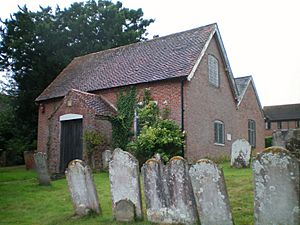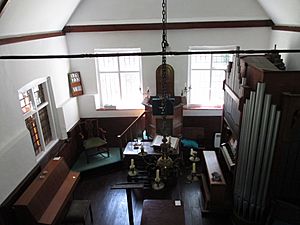Billingshurst Unitarian Chapel facts for kids
Quick facts for kids Billingshurst Unitarian Chapel (Known as 'The Chapel'). |
|
|---|---|
| Billingshurst Unitarian and Free Christian Church | |

The chapel from the east
|
|
| 51°01′18″N 0°27′11″W / 51.0218°N 0.4530°W | |
| Location | High Street, Billingshurst, West Sussex RH14 9QS |
| Country | England |
| Denomination | General Assembly of Unitarian and Free Christian Churches (British Unitarians) |
| Previous denomination | General Baptist |
| Website | www.thechapelatbillingshurst.com |
| History | |
| Former name(s) | Billingshurst General Baptist Chapel |
| Status | Chapel |
| Founded | 1754 |
| Founder(s) | William Evershed and William Turner |
| Architecture | |
| Functional status | Active |
| Heritage designation | Grade II |
| Designated | 22 September 1959 |
| Style | Georgian Vernacular |
| Groundbreaking | 1754 |
The Billingshurst Unitarian Chapel is a special place of worship in Billingshurst, a village in West Sussex, England. This building looks a bit like a small house. It was built in 1754 for a group called General Baptists. That's why it was first known as the Billingshurst General Baptist Chapel.
Over time, in the 1800s, the people who worshipped here started to follow Unitarian beliefs. They still do today. The chapel is part of the General Assembly of Unitarian and Free Christian Churches, which is the main group for Unitarians in Britain.
This chapel, also called the Billingshurst Unitarian and Free Christian Church, is one of the oldest Nonconformist places of worship in the Horsham area. Nonconformists are Christians who worship outside the main Church of England. This area has a long history of such Christian groups. There are very few older chapels of this kind in all of southeast England. English Heritage has given the chapel a special Grade II listing. This means it's an important building because of its history and how it was built.
Contents
History of the Chapel
Early Nonconformists in England
In England, people who worshipped outside the official Church of England were called Dissenters or Nonconformists. This was especially true if they were not part of the Roman Catholic Church. After a law called the Act of Uniformity 1662, many Church of England ministers who didn't agree with the new rules had to leave their churches.
This led to many new Christian groups forming. These groups focused more on a person's own connection with God. They were less about the formal ceremonies of the Anglican and Roman Catholic churches. This change happened all over Sussex. By the late 1600s, many new religious groups existed alongside the older, larger church.
The General Baptists Arrive
One of these new groups was the General Baptists. They became very popular early on in the area around Horsham, a market town in north Sussex. Other groups that also grew were the Religious Society of Friends (Quakers) and the Presbyterians.
By 1676, there were about 100 Nonconformists in Horsham. The General Baptist group was led by a local preacher named Matthew Caffyn. Under his guidance, a General Baptist chapel was started in Horsham in 1719. This brought together Baptists who had been meeting in small groups since the mid-1600s.
Building the Billingshurst Chapel
Many people from the village of Billingshurst, a few miles away, traveled to the Horsham chapel to worship. Eventually, this group became large enough to start their own chapel in Billingshurst.
They chose a grassy, raised spot on the west side of the High Street. In 1754, they built a simple, cottage-like chapel there. The chapel was founded by William Turner and William Evershed. Their initials and the date are carved on a stone tablet inside. William Evershed was a General Baptist preacher from Horsham who moved to a farm in Billingshurst in 1742. He and Turner held small meetings and preached in the village.
The Evershed family has had a connection with the chapel for 260 years! More than 120 Eversheds, from William himself to Susie Evershed who passed away in 2022, are buried or remembered in the large graveyard around the chapel. In 1753, Turner and Evershed bought the land for the chapel for three guineas. That was a lot of money back then! The chapel was officially registered for worship in October 1754. Because of its age, it's one of the oldest Nonconformist places of worship in the Horsham area and all of southeast England.
Like the Horsham group, the people at the Billingshurst chapel slowly changed their beliefs from General Baptist to Unitarianism in the early 1800s. The chapel then became known as the Billingshurst Free Christian Church, and later the Billingshurst Unitarian Chapel or Billingshurst Unitarian and Free Christian Church.
William Evershed also had a house in Godalming, Surrey. Hundreds of people attended meetings there every week in the mid-1700s. In 1783, that group decided to build their own meeting house. A General Baptist chapel was built there six years later, which also soon became Unitarian. It's still used today as Meadrow Unitarian Chapel.
Chapel Design and Features
The Billingshurst Unitarian Chapel is a simple building from the Georgian period. It looks like a quiet, old cottage. It has one floor and two windows, with a small porch in the middle. The front of the chapel is wide and has three sections. Its design is similar to an old chapel in Lewes, East Sussex.
The walls are made of grey and red bricks laid in a special pattern called Flemish bond. The roof is made of tiles. Experts have said that the building's design is "utterly self-effacing," meaning it doesn't try to stand out. It's a good example of how different a small, simple Nonconformist chapel was from a grand, old parish church. In Billingshurst, St Mary's Church, with its tall steeple, stands out on the east side of the High Street. Meanwhile, the Unitarian Chapel is "quietly hidden" behind iron fences and hedges on the west side. The chapel is set back about 8 feet (2.4 meters) from the High Street.
Inside the Chapel
The inside of the chapel is about 16 feet (4.9 meters) wide and 28.25 feet (8.6 meters) long. There's a simple wooden gallery at the north end of the ceiling. It's supported by one pillar and has a paneled front. Some of the original wooden beams are still on the ceiling.
Other interesting things inside include:
- An "impressive" clock made in 1756 by Inkpen of Horsham.
- Two coffin stools from 1787. These were used to hold a coffin before it was lowered into the grave. They have the initials "IK 87" (James Knight, 1787) carved on them.
- Original wooden pews, including two carved with "James Knight 1788."
- A brass chandelier with a dove figure.
- An original oak communion table.
The chapel has been changed and added to over the years. A wooden gallery was built in the late 1700s to make more space. The two pews with "James Knight 1788" carved on them are from this time. In 1825, a brick extension was added to the back (west side). This included rooms for a baptistery (a place for baptisms) and vestries (rooms for clergy).
The baptistery was originally open to the sky. But in 1880 or 1886, it was changed into a library and schoolroom. At the same time, the pulpit (where the preacher stands) was moved. It used to be near the entrance but is now on the south wall. The chapel is still in the middle of its original graveyard. However, new houses have been built very close to the chapel's edges, changing its surroundings a bit. The original path to the chapel from the east, a narrow lane between buildings, is still there. It almost hides the chapel from the High Street.
A writer in the 1800s described the chapel as:
A lovely, simple country chapel, with men and women sitting on different sides. The church leaders sat around a table in front of the pulpit. The singers were in the gallery, and the hymns started with the sound of a pitch pipe.
The Chapel Today
The Billingshurst Unitarian Chapel was given a Grade II listing by English Heritage on September 22, 1959. This means it's a "nationally important" building with "special interest." As of February 2001, there were 1,628 Grade II listed buildings in the Horsham area.
The chapel is a member of the General Assembly of Unitarian and Free Christian Churches, which is the main group for Unitarians in Britain.
In 2012, the people who attend the chapel started "Evershed Arts." They use the Old Library Room as an art space to encourage art in the local area. Between September 2014 and January 2015, the building was renovated. This was partly paid for by English Heritage Lottery funding and partly by money raised by the church members. Around this time, the congregation also decided to update their image. While its official name is still Billingshurst Unitarian Chapel, it is now often called 'The Chapel.' You can find its website at www.thechapelatbillingshurst.com.
See also






